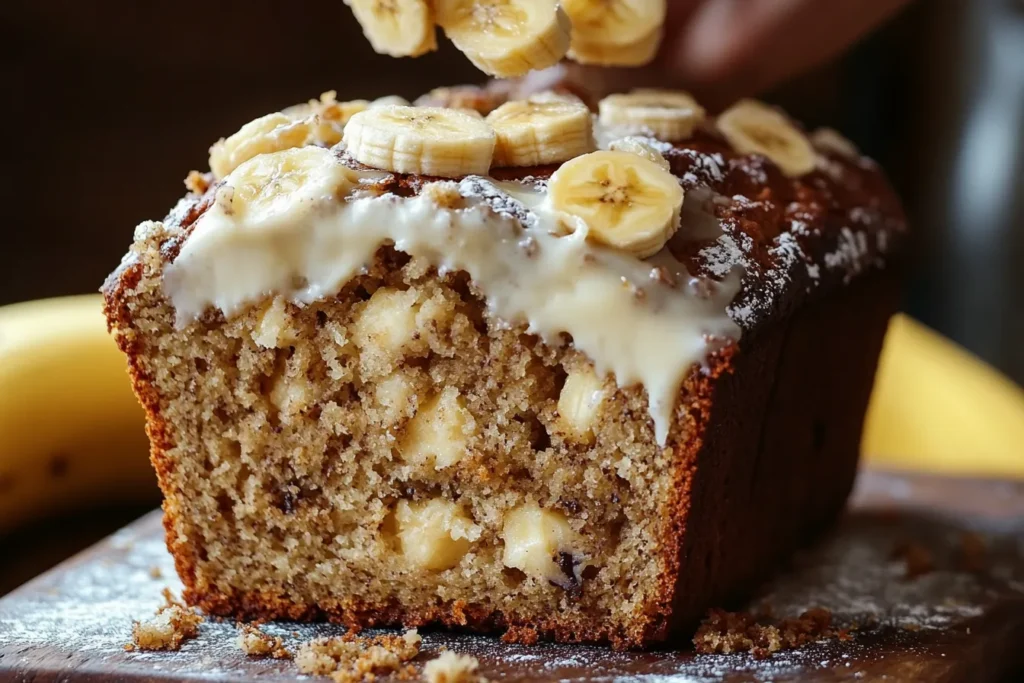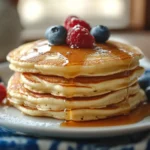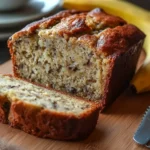Key Takeaways
- Understand the common reasons for dense and heavy ban-ana bread, such as over-mixing, incorrect flour measurements, and using unripe bananas.
- Learn the essential ingredients and their role in creating the perfect banana-bread formula.
- Discover the science behind fluffy texture, including the impact of leavening agents, temperature, and moisture balance.
- Explore the pros and cons of using oil versus butter in your ban-ana bread recipe.
- Master the mixing technique to achieve light and airy results, including proper ingredient order and folding methods.
- Understand the importance of temperature and timing in baking for optimal texture.
- Troubleshoot common texture problems and learn how to fix them.
Common Reasons for Dense and Heavy Banana Bread
Making the perfect ban-ana bread can be tricky. If your loaf is dense and heavy, don’t worry. It’s a common problem many bakers face. Knowing what causes it helps you fix your recipe and baking techniques.
Over-mixing the Batter
Over-mixing is a big reason for dense banana bread. It makes too much gluten, making the bread tough. Mix wet and dry ingredients just until they’re combined. Avoid stirring too much.
Wrong Flour Measurements
Using the wrong amount of flour can also make your bread dense. Too much flour absorbs moisture, stopping the bread from rising. Always measure flour accurately, by weight or by spooning it into the cup and leveling it off.
Using Unripe Bananas
The ripeness of bananas affects your bread’s texture. Unripe bananas are less sweet and have more starch, making the bread heavy. Choose ripe, sweet bananas for the best results.
| Reason | Impact on Texture | Solution |
|---|---|---|
| Over-mixing the Batter | Tough, dense texture | Mix just until the ingredients are combined, avoiding excessive stirring |
| Wrong Flour Measurements | Dry, dense texture | Measure flour accurately, either by weight or by gently spooning and leveling |
| Using Unripe Bananas | Heavy, dense texture | Use ripe, spotted bananas with a sweet aroma |
By fixing these common baking mistakes, you can make bana-na bread that’s light and fluffy. With a bit of care, you’ll soon be baking loaves that rival those from the bakery.
The Perfect Banana Bread Formula: Essential Ingredients
If you want to bake the perfect banana bread recipe, knowing the key ingredients is key. The formula for bana-na bread needs a mix of important parts for the right taste and texture. Let’s explore the essential ingredients that make bana-na bread so good.
Bananas: The Star of the Show
Ripe, mashed bananas are the heart of any banana bread recipe. They add sweetness and moisture, making the bread moist and tasty. Choose bananas that are spotty and a bit overripe for the best flavor and texture.
Flour: The Structure Builder
All-purpose flour is the go-to for bana-na bread. It gives the bread structure and stability. The right flour amount is key for the bread’s texture, whether you like it light or dense.
Eggs: The Binding Agent
Eggs are vital in the banana bread formula. They bind the ingredients together, making the bread tender and structured.
Butter or Oil: The Moisture Providers
Both butter and oil are used in bana-na bread recipes. Butter adds a creamy flavor, while oil makes the bread moist and soft.
Leavening Agents: The Rise Enhancers
Baking soda and baking powder are the leavening agents in banana bread. They help the bread rise and become light and airy, preventing it from being dense.
Knowing how each ingredient works in the bana-na bread formula lets you make a moist, tasty, and perfectly textured loaf every time.
| Ingredient | Purpose |
|---|---|
| Ripe Bananas | Provide moisture and natural sweetness |
| All-Purpose Flour | Offer structure and stability |
| Eggs | Serve as a binder and emulsifier |
| Butter or Oil | Contribute to the moist and tender texture |
| Baking Soda and Baking Powder | Enhance the rise and create an airy crumb |
Remember, the formula for banana bread is about finding the right mix of ingredients. With some trial and attention to detail, you’ll soon be baking amazing bana-na bread recipes.
Why Did My Banana Bread Not Come Out Fluffy? Understanding the Science
Baking science is key to making bana-na bread flu-ffy. It involves leavening agents, temperature, and moisture balance. Knowing these factors helps you get the right texture.
Role of Leavening Agents
Leavening agents like baking soda and baking powder are crucial. They release gases that make the bread rise. This makes the bread light and fluffy.
Temperature Impact on Texture
The baking temperature affects the bread’s texture. The right oven temperature helps the batter rise. If it’s too cool, the bread won’t rise well, making it dense.
Moisture Balance Basics
Getting the moisture balance right is essential. Too much liquid makes the bread soggy, while too little makes it dry. The goal is to find the perfect balance for a light crumb.
| Leavening Agent | Function | Impact on Texture |
|---|---|---|
| Baking Soda | Reacts with acid (such as buttermilk or sour cream) to produce carbon dioxide gas | Helps create a light, airy texture |
| Baking Powder | Contains both an acid and a base, which react to produce carbon dioxide gas | Provides additional leavening power for a fluffy result |
Understanding the science behind fluffy bana-na bread helps you improve your baking. You can adjust your recipe and techniques for a perfectly light loaf every time.
Oil vs. Butter in Banana Bread: Making the Right Choice
Choosing between oil or butter in banana bread affects the texture and taste. Knowing the benefits and drawbacks of each can guide your decision. This choice depends on what you like and what you want your bana-na bread to be like.
Oil-based bana-na breads are soft and moist. Vegetable or canola oil, being liquid at room temperature, keeps the bread tender. This makes oil-based banana bread great for those who want a soft, cake-like texture.
Butter-based bana-na breads, however, have a richer taste. Butter adds a creamy and nutty flavor, making it perfect for those who love a richer treat. The solid butter also makes the bread denser and more structured.
When deciding between oil or butter for bana-na bread, think about the bana-na bread ingredients you’ll use. The type of flour or added nuts or chocolate chips can affect how well oil or butter works. This is important for achieving the flavor you want.
In the end, the choice between oil or butter for banana bread is up to you. Whether you want a soft crumb or a richer taste, trying both can help you find the best bana-na bread ingredients for you.
Mastering the Mixing Technique for Light and Airy Results
Getting the perfect texture in bana-na bread starts with the right mixing technique. The order of adding ingredients and how you fold them matters a lot. Let’s explore the secrets to making a light and airy bana-na bread that will impress everyone.
Proper Ingredient Order
The order of mixing ingredients affects your bana-na bread’s texture. First, mix the dry ingredients like flour, baking soda, and spices in one bowl. Then, cream the wet ingredients, including butter or oil, sugar, and eggs, in another bowl. Finally, fold the wet ingredients into the dry ones gently, without overmixing.
Folding Methods
- Use a spatula or wooden spoon to gently fold the batter, being mindful not to over-stir.
- Incorporate air into the batter by using a figure-eight motion, cutting through the center and bringing the batter up and over.
- Avoid using an electric mixer, as this can lead to over-mixing and a dense, heavy texture.
Signs of Over-mixing
It’s easy to overmix when baking, but watch out for signs. If your banana bread is dense and tough, you’ve likely overmixed. Here are some signs to look out for:
- The batter becomes sticky and gloopy, losing its fluffy, airy consistency.
- You can see long, stringy gluten strands forming in the batter.
- The finished loaf has a tough, chewy texture instead of a light, tender crumb.
For a light and airy banana bread, use a gentle yet precise mixing technique. By following these tips, you’ll make banana bread that everyone will love.
Can You Replace Oil with Mashed Bananas? Pros and Cons
Many home cooks wonder if they can swap oil for mashed bananas in banana bread. This change might offer some benefits. But, it’s key to know the pros and cons before making the switch.
The Pros of Replacing Oil with Mashed Bananas
- Reduced Fat and Calories: Mashed bananas add moisture and richness without extra fat and calories.
- Enhanced Flavor: The natural sweetness and banana flavor can make the bread taste better.
- Improved Texture: Bananas can make the bread moist and tender, like oil does.
The Cons of Replacing Oil with Mashed Bananas
- Altered Texture: Using only mashed bananas can make the bread denser and heavier.
- Potential Baking Issues: The extra moisture can mess with rising and baking, leading to uneven results.
- Flavor Dominance: The banana flavor might overpower other tastes, making the bread one-dimensional.
To get the best results, try mixing mashed bananas with a bit of oil in your recipe. This mix can keep the bread’s texture and flavor right while cutting down on fat.
| Characteristic | Oil-Based Banana Bread | Banana-Based Banana Bread |
|---|---|---|
| Texture | Tender and light | Dense and heavy |
| Flavor | Balanced, with oil flavor | Strongly banana-forward |
| Fat and Calories | Higher | Lower |
Choosing to use mashed bananas instead of oil in banana bread depends on your taste and recipe. Try different methods to find the perfect mix of texture, flavor, and health benefits that you enjoy.
Temperature and Timing: Critical Baking Guidelines
Getting the perfect texture for banana bread depends on temperature and baking time. Knowing the best oven settings and how to check for doneness is key. This way, your banana bread will always be flu-ffy, moist, and delicious.
Optimal Oven Settings
The best oven temperature for banana bread is between 325°F to 350°F (165°C to 177°C). This range helps the bread rise evenly and get a golden crust without drying out. Make sure to preheat your oven well before baking to keep the temperature steady.
Testing for Doneness
Figuring out when banana bread is done can be tricky. But there are a few reliable ways to check. The toothpick test is common: stick a clean toothpick into the loaf’s center. If it comes out clean, your bread is ready. You can also press the bread’s top gently; it should spring back if it’s done.
The baking time for banana bread varies. It depends on the loaf pan size and the ingredients’ moisture. Generally, it takes 55 to 65 minutes. But start checking a few minutes early to avoid over-baking.
| Oven Temperature | Baking Time |
|---|---|
| 325°F to 350°F (165°C to 177°C) | 55 to 65 minutes |
By sticking to these guidelines, you’ll bake perfect, flu-ffy banana bread every time.
Troubleshooting Common Texture Problems
Getting the perfect banana bread texture is a delicate task. But with the right tips, you can fix common issues. This way, you’ll bake fluffy, moist banana bread every time. Let’s look at some common texture problems and how to solve them.
Dry and Crumbly Banana Bread
If your banana bread is dry and crumbly, it might lack moisture. Here are some fixes:
- Add more mashed ripe bananas to add sweetness and moisture.
- Use Greek yogurt or sour cream instead of some oil or butter for tenderness.
- Don’t overbake. Check for doneness a few minutes early.
Soggy and Dense Banana Bread
A dense and soggy texture means too much moisture. Here are some solutions:
- Use the right flour amount. Too much can make the bread heavy.
- Reduce the amount of wet ingredients like mashed bananas or milk.
- Preheat your oven correctly and bake for the full time.
By fixing these common banana bread texture issues and following good baking troubleshooting practices, you’ll get the light and moist texture everyone loves.
| Texture Problem | Possible Causes | Solutions |
|---|---|---|
| Dry and Crumbly |
|
|
| Soggy and Dense |
|
|
“Baking is a science, and understanding the principles behind good texture is key to consistent results.”
Conclusion
In this article, you learned how to make fluffy, light banana bread. You now know why banana bread can be dense and how to avoid it. You also understand the science behind baking it right.
Using the right ingredients and mixing methods is key. Follow the best baking tips to make banana bread that wows everyone. Don’t be shy to try new things and add your own twist to the recipe.
With these fluffy banana bread tips and a dedication to successful banana bread baking, you’re on your way to becoming a pro. Enjoy baking, relish the tasty outcomes, and share your love for baking with others. Happy baking!
FAQ
Is oil or butter better for banana bread?
Choosing between oil and butter for banana bread comes down to texture and taste. Oil makes the bread moist and tender. Butter, on the other hand, adds a richer flavor. Think about what you prefer and what you want your banana bread to be like.
What is the formula for banana bread?
Banana bread needs ripe bananas, flour, baking soda, baking powder, salt, sugar, eggs, and a fat source. You can use oil or melted butter. The right mix of these ingredients is key for the perfect banana bread.
Can I replace oil with banana?
Yes, you can swap oil for mashed bananas in banana bread. Using bananas makes the bread more moist and flavorful. But remember, bananas are wetter than oil, so you might need to adjust other ingredients to get the right texture.
What is the best banana bread recipe with oil?
Here’s a classic banana bread recipe with oil: Ingredients: – 1 3/4 cups all-purpose flour, – 1 teaspoon baking soda, – 1/4 teaspoon salt, – 1/2 cup vegetable or canola oil, – 3/4 cup granulated sugar, – 2 large eggs, – 1 1/2 cups mashed ripe bananas (about 3 medium), – 1 teaspoon vanilla extract, Instructions: 1. Preheat your oven to 350°F (175°C). Grease a 9×5-inch loaf pan. 2. In a medium bowl, whisk together the flour, baking soda, and salt. 3. In a separate large bowl, beat the oil and sugar until well combined. Then, add the eggs one at a time, mixing well after each addition. 4. Fold in the mashed bananas and vanilla extract until just combined. 5. Gradually add the dry ingredients to the wet ingredients, mixing just until no dry pockets remain. 6. Pour the batter into the prepared loaf pan and bake for 55-65 minutes, or until a toothpick inserted in the center comes out clean. 7. Allow the banana bread to cool in the pan for 10 minutes before transferring it to a wire rack to cool completely before slicing and serving.







